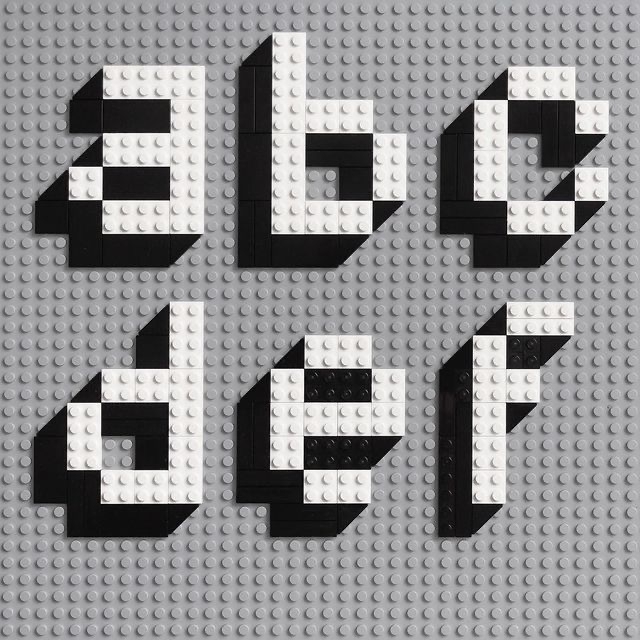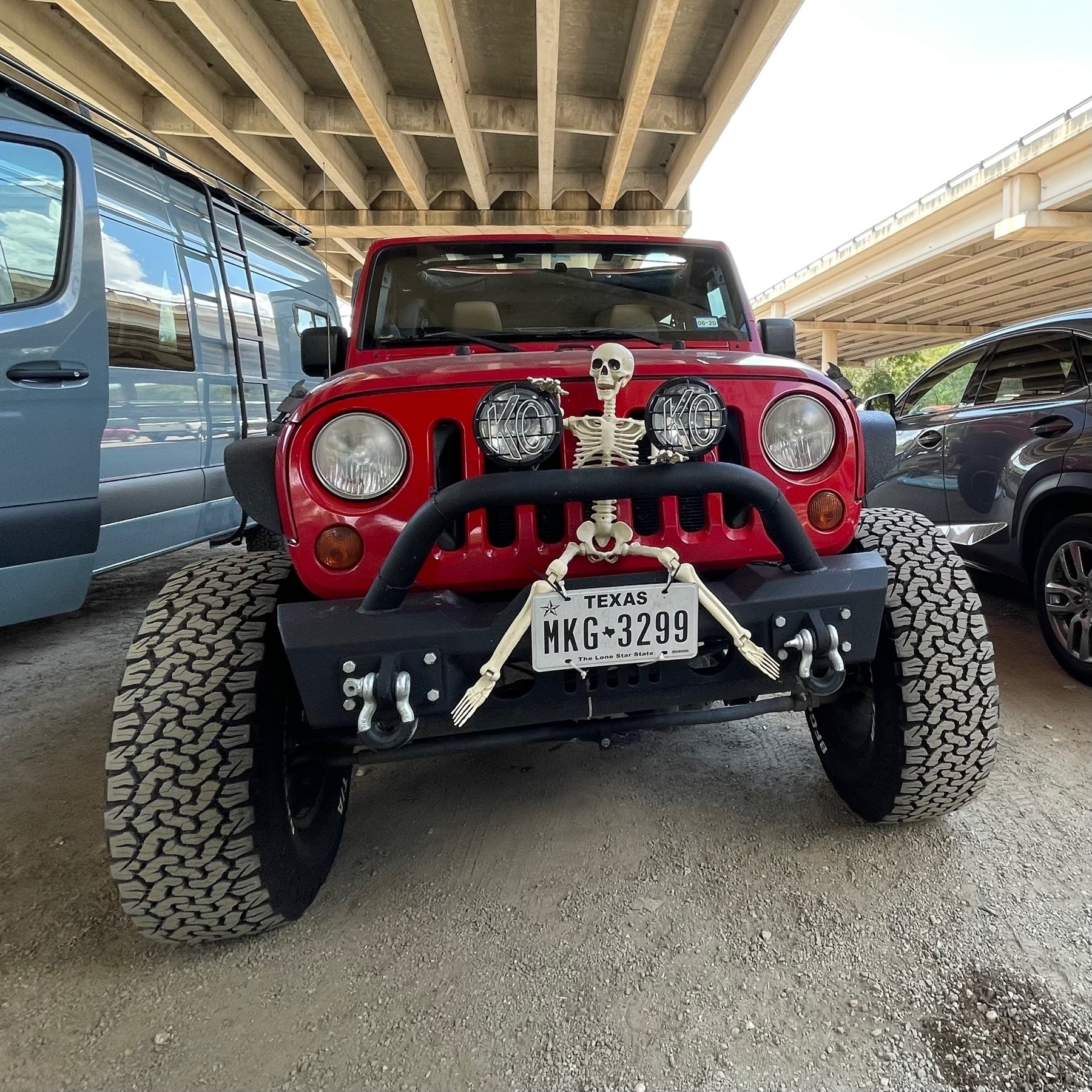Brik Font
Craig Ward’s Brik Font project gives me a huge smile but also hurts my brain. Am I seeing something that’s near or something that’s rendered to look as if it’s near although it’s far? It’s genius.


Via Kottke.
Craig Ward’s Brik Font project gives me a huge smile but also hurts my brain. Am I seeing something that’s near or something that’s rendered to look as if it’s near although it’s far? It’s genius.


Via Kottke.
Centre d’Expérimentation Musicale - Gaël Chabot-Leclerc, créateur en résidence - Facebook
My brother, talking about his new music creation centered around cut glass carboys. I’m impressed by how natural he is in front of the camera.
The first credit card was introduced in 1950. Store credit, installment credit, personal loans, payday loans – everything took off. And interest on all debt, including credit cards, was tax deductible at the time.
Morgan Housel in How This All Happened, an overall great read.
Moxie Marlinspike >> My first impressions of web3. Overall, not positive. I knew the “art” of the an NFT was not stored on the blockchain, but I didnt know the data was just a url. There is no hash of what’s at the other end of that url.
San Salvador is a voice and percussions ensemble who sings in Occitan, or “langue d’oc” in French. They’re my new favorite band. The rhythm and vocal harmonies are right up my alley. The energy they project in the video embedded above is stunning. I hope I get to see them live one day.
Their music reminded my of Barbatuques’ Baianá.
Via Emma Bauchner’s New Sounds 2021 year in review.
Giacometti – Grande femme debout I. MFA, Houston.

This is installment #5 of the annual holiday newsletter I share with my colleagues at Enthought. (2020, 2019, 2018 and 2017).
Unlike in 2019 and 2020, I didn’t keep track of interesting things as the year went by. Big mistake. Nonetheless, I hope you find one or two interesting things below!
Happy holidays to you all, and happy reading/watching/listening!
If you’ve talked to me this year, there’s a good chance I talked about Wardley Maps. It’s a tool for mapping “competitive landscapes.” This means picking a set of users’ needs, breaking them into the value chain of their components, and placing the components on a map based on how far they are from the user’s needs and how evolved they are. One can then make business decisions based on the map. Here’s one Simon Wardley made for the photo-sharing business he ran in the early 2000s.

Image from Simon Wardley’s Finding a path.
Wardley makes a compelling case for using maps to make decisions. In chess, moving a pawn isn’t a good or a bad move in itself, it all depends on the situation. In war, the flanking move is the move in a particular situation and not in others. In both cases, you use a map to make the decision. Why would business be different?
He goes on to overlay many business and management concepts on top of the maps. Here are a few:
I feel like Wardley stumbled on a Truth of the Universe. Even though it’s likely not to be 100% correct I sure think he’s onto something valuable.
If you’re interested in digging deeper, Wardley wrote a long series of articles that were collated into a book. I’m about a third of the way through and it’s excellent. Hat tip to Rahul for pointing me to Wardley’s talk, Crossing the River by Feeling the Stones.
In August, I added Four Thousand Weeks: Time Management for Mortals to my reading list because Adam Grant, Ryan Holidays, and Austin Kleon recommended it. Then I forgot about it. Then I read Too many needles by Oliver Burkeman, which 🤯. Why do I stress about reading everything on my reading list(s) but not about reading everything that’s in the British Library? Then I read What if you never sort your life out? by Burkeman. Then I read How to make writing less hard by Burkeman. Then someone mentioned Four Thousand Weeks by Burkeman and I went Oh. So I read Four Thousand Weeks. If you feel like there’s too much to do and not enough time to do it all, this may be the right book for you (it was for me).
I can’t remember how I ended up on apenwarr.ca the first time, but every single thing I read was mind opening. The author is Avery Pennarun, co-founder of Tailscale (and author of git-subtree?!). I enjoyed his software engineering simulator series. In SimSWE part 1: Indecisiveness simulator, he makes a strong case for deciding on release goals and then completing them. In SimSWE part 2: The perils of multitasking, he makes an equally strong point that releasing often brings more value to your users, which he explores again in SimSWE 4: Wants, needs, and chasm-crossing. This time the focus is on shipping first what users need instead of what users want. And then there’s the monstrous and fabulous An epic treatise on scheduling, bug tracking, and triage. It’s too big to summarize, but some key points:
And finally, in Highlights on “quality,” and Deming’s work as it applies to software development Pennarun sent me back towards W. Edwards Deming’s work, who was Bob Moesta’s mentor (mentioned in the 2020 newsletter). Deming is often considered a father of the Japanese Quality Revolution. Deming is on my 2022 list.
After mentioning it last year, I managed to play with Simon Willison’s datasette project. It’s an SQLite-centric tool for “publishing and exploring data”, where you published the data with the code. Simon calls it the “baked data pattern.” In April, I made a code search engine that searches across all ETS repos using the datasette-ripgrep plugin. The hardest part was, by far, pushing the code to Google Cloud Run. It took me only two months. Later in the year, I played with dogsheep-beta to build a “personal search engine” built as a collection of SQLite files with a search index implementing the denormalized query engine pattern. I don’t have code published for that yet, but it’s been a fun project to collect notes, reading and watching lists, listening histories, location data, and bookmarks in a single searchable interface. In a way, I’m competing with Neeva (but I’m not going full-Linus). The next thing I’d like to play with is Git scrapping and git-history.
Austin Kleon talks about the 13-month International Fixed Calendar. It reminds of the ISO week numbers that the Danes love so much. It always weirded me out when they asked “Are you free week 14?” Thinking back, they might have been onto something.
A trio of articles on the relationship between open source maintainers and the people who use their software. Brett Canon writes The Social Contract of Open Source. Rich Hickey writes Open Source is Not About You. And Drew Devault writes Provided “as is”, without warranty of any kind.
Dan Lu had many great pieces this year but I particularly liked Some reasons to work on productivity and velocity. What resonated with me was the idea that there are “phase changes” in the nature of the work you can tackle as your velocity increases and your feedback loops shorten. With low velocity and long loops, you plan longer because you don’t want to waste an iteration. With high velocity and short loops, new problems become tractable, it’s easier to stay motivated, to stay in the flow. Nearly all the consulting projects we work on aim to achieve that. Do read the whole thing.
Two articles about cybernetics, “the science of communications and automatic control systems in both machines and living things” says Wikipedia. (I realized they were linked as I wrote this.) In Problem-Solving in Music, Art, Science & Software, Jessica Kerr ties together camerata (groups of people working on a common problem) and cybernetics applied to software development. And in Notes are conversations across time, Gordon Brander discusses how note-taking is a cybernetic feedback loop between yourself today and your future self. Another thought that crossed my mind while reading was conversations as gradient descent towards shared understanding.
David Wiley is a big wig in the open educational resources movement. And yet, in We Should Pause and Ask the Question he asks: is openness what we should strive for? Does “open” really mean increased access? Instead, he suggests evaluating educational resources in terms of their success, scale, and savings for students. For example: “as of March 1, 2021, 985,081 people have enrolled in Python for Everybody on Coursera and […] no one has stood up the tool chain themselves.” He also has this great quote given to him when he was a Shuttleworth Fellow: “don’t let your principles keep you from accomplishing your mission.”
Ryan Singer published 19 short articles on product management, shaping, pattern languages, and usability. They’re all worth a read.
A virtuous cycle for analytics by Jon Udell. A series of articles on providing data to users and mixing Postgres with Python.
Julia Evans on patterns in confusing explanations.
Chelsea Troy on The Art of Documentation.
I read few books, but thankfully they were great.
Good Strategy/Bad Strategy by Richard Rumelt. This one made for a delightful and useful book club. Most strategy is bad. It’s all fluff, goals, and bad objectives. See for example Simon Wardley’s (him again) bad strategy generator. Good strategy has a kernel: a diagnosis, a guiding policy, and coherent actions.
The Art of Gathering: How We Meet and Why It Matters by Priya Parker blew my mind. I got giddy reading it, like when I first read Flour Water Salt Yeast. I felt like I had put my hands on a truth of the universe that I knew existed but didn’t have a word for, or that someone with super powers wrote a guide for how to be a superhero like them. I keep thinking of how it applies to dinner parties, meetings, and classes. I’ll be re-reading this one.
Creative Selection by Ken Kocienda. Kocienda was on the small team of people who developed the original software for the iPhone. He was in charge of the keyboard. What struck me the most was Apple’s prototyping culture. They build a thing and then critique it. There are no wireframes. It reminded me of Basecamp’s Getting Real and more recently, of Jason Fried’s MVP: Minimum Viable Pie.
Most of the videos I end up watching are from the incomparable Jason Kottke.
Two Lego-centric videos: In the first, someone builds a car that can climb obstacles, and in the second, the car crosses a gap of increasing length. Watch both until the end for the satisfying bits.
More Lego. This time a flexible plane made out of solid blocks.
Mesmerizing Matchstick Stop Motion Video: I’m very patient, but not patient enough to make this if it’s indeed pure stop motion.
Every Sport a Bowling Ball. Just what it says on the tin.
Tom7 creates the uppestcase and lowestcase letters by training two deep learning models: one to create uppercase letters from lowercase ones, and the other to create lowercase letters from uppercase ones. Then he pushes things (beyond) their logical conclusions, such as creating lowercase versions of lowercase letters, and uppercase versions of uppercase letters. The results are fonts you can download and “use.” In the process, he builds a lot of really neat custom UIs to visualize what the models are doing. It’s entertaining and interesting.
Designing and Evaluating Reusable Components by Casey Muratori: I find it fascinating when an expert can externalize their knowledge and doesn’t just bask in expert blindness. Not only can Muratori explain why he thinks some API are good and some not, but he can give you a checklist so you can follow the same thought process. (Thanks Scott M. for the recommendation!)
Borgen could be considered a Danish The West Wing. But with better home life scenes, less world drama, more personal drama, more media drama, and more awesome Danish furniture. It’s an interesting story with great acting. It came out while I lived in Denmark and was all the rage then, but didn’t watch it until now.
Rita another Danish series. This one, a mostly light-hearted comedy-drama about a teacher who stands ups for the kids, but is terrible to grown ups. Again, awesome Danish furniture.
The General is a 1926 movie by Buster Keaton. One could call it a 100-year-old blockbuster. Action-packed, funny. On Roger Ebert’s top 10 list.
I watched Ford V. Ferrari at my into-cars friend’s recommendation. I knew nothing about it when I started watching it and enjoyed it until the last few minutes, when something so incredible, so preposterous happened that it changed my entire appreciation of the movie. Now I love it.
I bought a whetstone years ago but sharpened knives only one or twice a year. This year I read somewhere the story of someone in a similar situation whose brother-in-law (or the likes) said, as he saw him sharpen knives: “Are you planning on becoming a sharpening master or on having your knives in a museum? If not, get a knife sharpener and move on with your life.” So I bought a refurbished knife sharpener from Brod & Taylor. It’s awesome and now we have sharp knives every day.
Our house-purchasing process took 7 months and it was traumatic. But thankfully, memory is a faculty that forgets. In the end, I say it was worth it for us.
Anna and I went to Big Bend in March (which was great!). About a mile from the parking lot, my “normal” hiking boots started to hurt my ankle so Anna, my hero, dropped her backpack, took my boots and went back to the car to bring back her and my pair of not-made-for hiking Vivobarefoot boots. We went our merry way without pain for the rest of the 3-day hike and both bought a pair of Trackers the day we came back to Austin. They’re amazing.
The Ultimate Texas Tacopedia by Texas Monthly.
Hey, Let’s Watch Jacques Pépin Fry Eggs with a fork in a non-stick pan!
Follow a drop of water as it makes its way to the ocean with River Runner.
Kinopio is a quirky and surprisingly powerful alternative to visual thinking tools like Jamboard, Miro, or Whimsical. It’s built as a single 150kb Vue.js client-side file. The server backend component is only involved in backups and syncing. It’s developed by @pketh, co-creator of Glitch. He writes a weird and interesting blog.
I listened to more than 43,400 minutes of music by about 1,460 artists across 161 genres (says Spotify). TOBACCO was the artist I listened to the most. I must have been in a weird groove at the beginning of the year because I listened to the album Hot Wet & Sassy 26 times.
Every album I enjoyed this year is in a playlist, but here’s a short list of outstanding albums:
Jon Udell, A virtuous cycle for analytics:
We recognize this software pattern in the way application programmers who push a system to its limits induce systems programmers to respond with APIs that expand those limits. I suppose it’s harder to see when the application environment is Metabase and the systems environment is Postgres. But it’s the same pattern, and it is powerful.
See also scientists and engineers who can program well enough to validate that their ideas work and then hand them off to developers to scale them.
I’m making a distinction between using Metabase, in Jon’s post, and learning programming because in many cases, scientific and engineering questions can’t be answered (sadly) with SQL queries and a nice friendly UI like Metabase’s.
Zilker Park parking

The amazing song Thème de Yoyo is in fact a 1970 piece by the Art Ensemble of Chicago and not by Motorpsycho and Jaga Jazzist, as I’ve thought for years. I realized this today after hearing The Cinematic Orchestra’s version and thinking: This has to be a cover. The nice thing about this discovery is that if there is one cover, there are many!